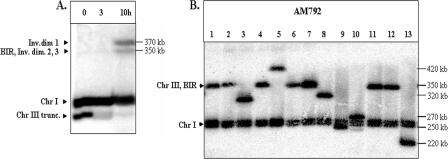FIG. 7.
Repair intermediates and chromosome alterations in the RAD51/RAD51 diploid AM792. (A) Formation of inverted dimers (Inv.dim) in AM792. DNA was prepared for PFGE at intervals after induction of DSBs at MATa in nocodazole-arrested AM792. Southern blots were hybridized with ADE1-specific probe, which hybridizes to chromosome (Chr) I, to the truncated (trunc.) chromosome III, and to the repair products. The appearance of two repair products is shown. Inverted dimer 1 corresponds to the 370-kb dicentric dimer described for AM919. As expected, it does not hybridize to a THR4 probe (data not shown). The expected positions of the smaller repair intermediates (inverted dimers 2 and 3) are at the same positions expected for a BIR event, in which the truncated copy of chromosome III is repaired using the other homologue as a template. Thus, we cannot distinguish among these events. (B) DSB repair in AM792 leads to chromosome aberrations. DSBs were induced in nocodazole-arrested AM792 cells. The nocodazole was removed, and the cells were then plated to medium lacking adenine. DNA isolated from the resulting Ade+ colonies was analyzed by PFGE, followed by hybridization with an ADE1-specific probe. These strains had a chromosome III that was about 350 kb in length (suggestive of repair by BIR) or a chromosome III that was distinctly larger or smaller than 350 kb, indicating a chromosome rearrangement.

